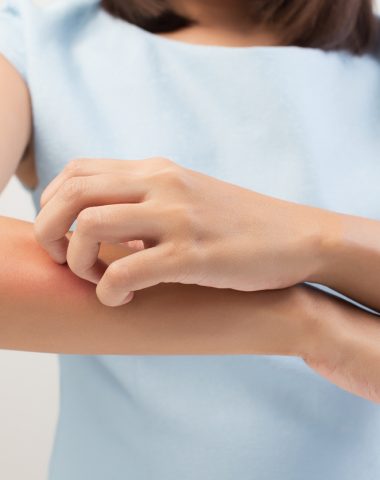Banish Itchy Skin
The terms “eczema” or “dermatitis” are used to describe a group of skin conditions characterized by inflamed skin. Eczema can be red, blistering, oozing, scaly, brownish, or thickened and usually itches.
Eczema shows up most often on the face, hands, feet, wrists and the back of the knees (though it can appear in other areas). The affected skin often appears dry, thick and even scaly.
The most common symptom is intense itchiness. Occasionally the skin will start itching even before the rash surfaces.
Eczema or atopic dermatitis, is an inflammatory skin condition, where the skin thickens and roughens. It is typically itchy, and sometimes can be extremely itchy, creating a scratch-itch cycle that perpetuates the skin lesions.
What Causes Eczema
It’s still not known exactly what causes eczema. The most common type of eczema – atopic dermatitis – resembles an allergy. But the skin irritation, which is more often seen in children rather than adults, is not an allergic reaction.
It is currently believed that that eczema is caused by a combination of factors that include:
- Genetics
- Abnormal function of the immune system
- Environment
- Activities that may cause skin to be more sensitive
- Defects in the skin barrier that allow moisture out and germs in
In eczema, the immune system is “overreactive” and hastens the production of new skin, thereby creating the patchy, thickened appearance, characteristic of eczema.
Certain food or environmental allergens may trigger a hyperreactive response from the immune system, which then presents on the skin. It is important to determine if and to what degree these triggers are contributing to your eczema.
Some people may have “flare-ups” of the itchy rash in response to certain substances or conditions. For some, coming into contact with rough or coarse materials may cause the skin to become itchy. For others, feeling too hot or too cold, exposure to certain household products like soap or detergent, or coming into contact with animal dander may cause an outbreak. Upper respiratory infections or colds may also be triggers. Stress may cause the condition to worse
Different Types Of Eczema
There are several different types of eczema. Unfortunate patients may have more than one type at a time. Here are the main types of eczema with a description of their characteristics.
Atopic Dermatitis – The most common form of eczema, atopic dermatitis is chronic and inflammatory. Atopic dermatitis is related to asthma and hay fever, but it is not an allergy. Still, the immune system overreacting to irritants, whether inside or outside the body, is behind the chronic flare-ups. The symptoms listed above are for atopic dermatitis.
Contact Dermatitis – When a person with contact dermatitis touches irritating substances or allergens, his or her skin becomes inflamed, causing it to burn, itch, and become red. Irritant contact dermatitis and allergic contact dermatitis are the most common forms.
Dyshidrotic Eczema – This form of eczema produces small, itchy blisters on the edges of the fingers, toes, palms, and soles of the feet. Twice as prevalent in women as men, dyshidrotic eczema may be triggered by stress, allergies, moist hands and feet, or exposure to nickel in jewelry, cobalt in metal objects and some paints, or chromium salts in cement, leather, paint, and other products.
Neurodermatitis – This form of eczema starts with an itchy patch of skin. These occur in commonly scratched areas, and scratching then makes the areas more irritated and itchy. This itch-scratch cycle causes the affected skin to become thick and leathery. Neurodermatitis occurs in areas that can be reached and scratched: the head, neck, wrists, forearms, ankles, vulva, scrotum, and anus. Treatment success depends on the patient being able to resist the urge to rub or itch the affected areas, but this can be difficult as the itching can be intense.
Nummular Dermatitis – This form of eczema looks much different than other more common forms. Patients with nummular dermatitis develop coin-shaped spots on their skin. These spots can be very itchy and difficult to treat. It is thought that nummular dermatitis can be triggered by insect bites, reactions to skin inflammation, or dry skin in the winter.
Seborrheic Dermatitis – Another chronic form of eczema, seborrheic dermatitis appears on areas of the body where there are a lot of oil-producing sebaceous glands, such as the upper back, scalp, and the nose. This form of eczema is common in infants and is known colloquially as “cradle cap.” In adults, it also commonly appears on the scalp. Symptoms may range from dry flakes (dandruff) to yellow, greasy scales with reddened skin. It’s thought that hormones play a role in this form of eczema.
Stasis Dermatitis – Also known as venous eczema, this occurs when the patient has a problem with blood flow in the veins and pressure develops. This pressure can cause fluid to leak out of the veins and into the skin, resulting in stasis dermatitis. This usually occurs in the lower legs. Symptoms include swelling around the ankles, redness, scaling, itching, and pain.
How We Treat Eczema
After checking your skin, discussing your symptoms, your health history, and your family history of eczema or allergies, Dr. Rao will be able to tell if it’s eczema. From there, treatment options may depend on the severity of your inflammation, and what type of eczema you have. Please fill in the form below to book your consultation.

